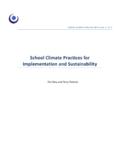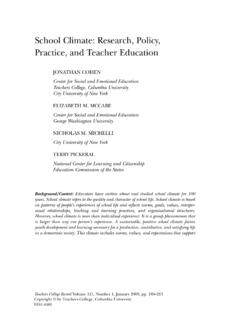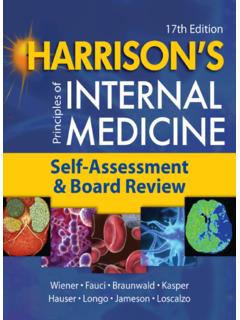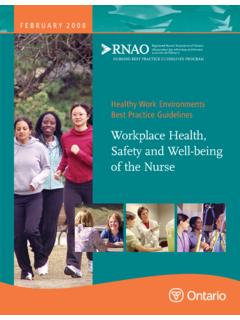Transcription of CAROL HAYDEN INSTITUTE OF CRIMINAL JUSTICE STUDIES U ...
1 International Journal of Violence and School 9 September 2009 8 DEVIANCE AND VIOLENCE IN SCHOOLS A REVIEW OF THE EVIDENCE IN ENGLAND1 CAROL HAYDEN , INSTITUTE OF CRIMINAL JUSTICE STUDIES , UNIVERSITY OF PORTSMOUTH ABSTRACT The article outlines the nature and development of the debate about deviance and violence in schools in England. It explains disciplinary differences in the use of terminology. The focus is on summarising the most recent evidence about the nature and extent of these issues. Policy and practice developments targeted at reducing problem behaviour in and around schools are discussed. The article concludes that there is a great deal of survey and monitoring data in England but a relative lack of in-depth and ethnographic research.
2 KEYWORDS England, deviance and violence, schools 1 The focus is on England, rather than Britain (England, Scotland and Wales) or the United Kingdom (which includes Northern Ireland). Although the four countries have the same government there is a degree of devolution of power that means that there are important differences in the way that the education systems are run, as well as differences in legal governance. The central government Department for Children Families and Schools (DCSF) covers England and Wales only. A few references include evidence from Wales, as well as England; there is one reference to an important longitudinal survey carried out in Scotland.
3 Deviance and violence in schools 9 BACKGROUND AND INTRODUCTION FOCUS AND APPROACH OF THE REVIEW This review is focused on England and on the most recent research and developments, referring to older research and reports only when they are considered to be landmark or seminal STUDIES . As shorthand this paper will at times refer to problem behaviour when not specifically referring to CRIMINAL behaviour (that is behaviour that breaks the CRIMINAL law) or specific types of behaviour that are clearly defined in research, as in the concept of bullying. The approach taken in this review is inter-disciplinary, but it is most centrally informed by criminology, social policy and education research.
4 The move to Children s Departments in England in recent years has meant that a more inter-disciplinary approach is increasingly appropriate and particularly in relation to the focus of this review. It is acknowledged that there are mental health issues that may relate to the behaviour of young people in schools (Cowie et al, 2004) but this is not the main focus of this review. There is a great deal of research (Gillborn, 2008) as well as government monitoring data on ethnicity and schools (see for example, DfES, 2006). Monitoring gender and special educational need is an aspect of various annual national reports on schools and the educational system (see the for a range of relevant reports). Research on gender (Osler et al, 2001) and special educational need (Visser et al, 2001) is also plentiful.
5 These are all highly complex issues that cannot be covered adequately in a single review. The review was undertaken by updating existing reviews and collections (see for example Debarbieux and Blaya, 2001) on the subject of violence and various forms of behaviour problems in schools in England (see relevant concepts and terminology in Figure 1). The social science bibliographic database Assia was searched in order to located the most up-to-date published research. Research commissioned and published by the relevant government departments was located through their websites; as was that commissioned by the largest teaching unions. TERMINOLOGY The terminology used in England is quite complex and inevitably influenced by disciplinary, professional and political perspectives.
6 Deviance as a concept is strongly associated with criminology but is also recognised as including non- CRIMINAL infringements of social norms. Deviance as a concept, in both popular and academic discourse in England, has been replaced to a large extent by the concept of anti-social behaviour (Home International Journal of Violence and School 9 September 2009 10 Office, 2004; Rutter et al, 1998). The use of the word violence generally refers to physically aggressive or threatening behaviour in England (Wright and Keetley, 2003). Figure 1 gives an overview of the concepts and terminology used in this review. Teachers and schools focus most on various pupil behaviours.
7 Most often they refer to disruptive , disaffected and bullying behaviours, or sometimes behaviour is said to be challenging. These terms are associated with the particular focus of the behavioural description: for example, disruptive refers to the interruption of the work of the teacher and other pupils, or even the smooth working of the school; disaffected relates to a range of behaviours that imply a lack of affection for school and may include disruptive behaviour and non-attendance. Challenging or inappropriate behaviour are other terms used by teachers in relation to how a behaviour impacts on them, or the school context. Bullying behaviour is a strong and specific focus of research and campaigns in relation to pupil behaviour.
8 Bullying is usually seen as a particular subset of aggressive and violent behaviours. The very serious nature of some bullying has led Hall and HAYDEN (2007) to debate whether some forms of bullying could be conceptualised as hate crime. Deviance and violence in schools 11 This review will cover the key evidence about the various problematic behaviours (shown in Figure 1) that together make up the available research on deviance and violence in English schools. It should be borne in mind whilst reading this review that the boundaries between behaviours that break with social norms or rules and those that break the CRIMINAL law have become increasingly blurred in recent years in England.
9 This has happened partly as a result of the focus on crime prevention (and the criminalisation of social policy, Rodger, 2008) and, partly because there is in any case the possibility for interpreting actions in more than one way. For example, when does a playground fight become assault ? CONTEXT DEVELOPMENT OF CONCERNS Although there is evidence of some concern about the behaviour of young people in school wherever there are historical records (see Tubbs, 1996). A more specific concern began to grow in England following the raising of the school leaving age in 1973. At the time this concern focussed on disruptive behaviour and discipline problems and led to a government enquiry, known as The Elton Report (DES/WO, 1989).
10 The specific problem of bullying in schools was increasingly recognized during the 1990s and has been a focus of school based research and interventions ever since. In recent years there has been a national annual Anti-Bullying Week. The Education Reform Act 1988 is often seen as a watershed in relation to how schools are evaluated and what teachers can do to motivate all pupils. Prior to this Act, teachers had more freedom in what they taught and could devise courses for young people who did not respond well to traditional academic study. The Act led to the imposition of a National Curriculum on schools, this resulted in direct comparisons of test results between schools and the creation of league tables of school test and examination results.






